If you’re joining us just now, follow the snake’s tail to the Prologue or climb a ladder to the Table of Contents.
Chapter 2: The Science and Lore of Unborn Universes
Evan boarded the plane and handed his ticket to the pretty Australian flight attendant.
“Looks like you’re in the back,” she told him. “You’ll need to store your carry-on in one of the overhead bins closer to the front, because the back bins are reserved.”
“Wow, who got stuck with those cheap-ass seats?” Evan asked.
“No one’s sitting in them,” she said with a smirk. “They’re reserved for the plane’s medical supplies and whatnot.”
“I know,” Evan said. “I’m just joshing with you. I’m not that dumb.”
“I didn’t say you were dumb,” the flight attendant said, blushing.
“Ha!” he said. “Gotcha! I knew you were gonna think I thought you were making fun of me. That’s why I replied the way I did. This is how I pick up girls in the States… People say I’m pretty complicated.”
“I wouldn’t put too much stock in what those people say,” she replied.
“I know, right?” he said with a grin, although he suspected he just got slammed.
“Could you please go,” the man behind Evan said.
“Sorry,” Evan said, continuing down the aisle. But he turned around one last time before he left first class and said to the flight attendant, “I was also just joshing with you when I said I wasn’t dumb… I’m pretty dense.”
He was happy with that parting shot. It’s like a double blind, he thought. Now she’s gonna say to herself “Maybe he’s not as dumb as I thought.”
Evan had an aisle seat in the second to the last row. It was less than seven feet from the lavatory. He put his backpack in a bin a few rows up and went back to his seat. Guess I’m ridin’ steerage all the way to Cali, he mused.
Luckily there was an empty seat between him and the woman by the window. She seemed angry about something. She wore a T-shirt that said “Loud, Proud Hoosier.”
“Are you from Ohio?” Evan asked.
“Indiana,” she said, glaring at him.
“That’s right,” Evan nodded. “I knew it was one of them middle states.”
She looked at the decal on her shirt as if only now noticing it. “If you’re assuming my shirt means I’m proud because I’m from Indiana, that’s not the reason,” she remarked. “It’s the other meaning of ‘pride’.”
“Oh,” Evan said. He had no idea what she was talking about so he said, “that’s awesome. I’m from California. We’re pretty proud there.”
She turned away and looked out the window.
The plane took off and banked steeply enough for Evan to peer over the lady’s shoulder at the saline lights of Sydney far below.
Almost immediately after reaching the cruising altitude, dinner was served. Evan ordered fish. The pretty flight attendant let him have three glasses of wine for free. She didn’t even ask to see his ID. After he was done with the meal, she returned with the push-cart to collect the dishes. She took his plate, flatware, and wine glass.
Evan snapped his tray back into place—“in the upright position,” he said while grinning at her slyly. “That would be fun,” he added.
“You’re what my grandfather would’ve called a rum one,” she replied. “I think we’d better cut you off for the remainder of the flight.”
“Fine by me,” he said with a shrug. “I’m prolly gonna rack out anyway.”
The aisle next to him got crowded as people queued up to use the lavatory. A man stepped on Evan’s foot.
“Sorry,” he said.
“No problem,” Evan replied.
Why’d she call me a rum one? he wondered. I was drinking wine.
When the aisle was clear, Evan thought he’d better visit the lavatory, too, before settling in for the night. By the time he got back to his seat, the cabin lights were doused. Everyone was preparing to bed down for the 15.5 hour flight to LAX. Complimentary blankets and foam pillows were being distributed. Evan took one of the pillows but told the flight attendant he didn’t need a blanket.
“I’m always hot,” he said, grinning ambiguously.
He removed the inert singularity from his pocket and contemplated it in his palm. It was still in the meshes of the lint.
The loud, proud Hoosier lifted her eye-mask and looked at him coldly. She was trying to sleep.
“My bad,” he said. He put it back in his right pocket. The man behind him was already asleep so Evan leaned his own seat back carefully, trying not to wake him.
Evan sat wide-eyed in his seat. It had probably been a bad idea to drink so much alcohol so late at night because now his brain was all keyed up even though he was physically beat. He started thinking about the classes he’d taken and the documentaries and TV shows that he’d seen about inert singularities.
Two years ago he had enrolled in a dumbed-down course on the subject at UCLA. Marcus told him the class was geared for people who hated math and science “like you, bro.” It satisfied three of the twelve science credits Evan would need to graduate. It was called “Inert Singularities for Poets and Philosophers.”
He remembered the professor talking about how unborn universes were considered subatomic particles and that they shared many of the characteristics of neutrinos. They had zero mass and no electric charge, for the simple reason that they didn’t exist.
One of Evan’s classmates, an attractive girl from Philly, asked how inert singularities produced light if they had no electric charge.
The professor explained that the glow or shimmer that inert singularity seemed to emit was a kind of spark generated at the point in spacetime where non-existence overlaid reality for a brief moment and displaced it. Then the professor drew two circles on the chalkboard. He scribbled “inert sing.” over one and “footprint” over the other.
“Basically,” the professor said, gesturing to the diagram, “the glow you see is the footprint (or ghost) of an inert singularity. You’re seeing where it was the moment before, but where it is no longer. Unborn universes are invisible to the naked eye.”
There were many features of this highly esoteric field of particle physics that scientists still didn’t understand. Why were there so many inert singularities on the planet Earth where the sun rises in the west? Where did they come from? How was it that they seemed to move autonomously?
According to the professor, singularities were immune to the laws of physical motion and gravity—“except,” he added, “when they choose to comply with them. They move in erratic and highly irregular ways, but tend to do so only when not being observed, which is to say always, since they are unobservable.”
This made no sense to Evan, so he just ogled the girl from Philly.
“A boy might trap an inert singularity in a jar,” the professor continued, “and place the jar on his nightstand before going to bed, only to discover it in his sister’s dollhouse the following morning.”
Whenever scientists tried to runs experiments on inert singularities, the singularities often chose to thwart these, sometimes in rather cheeky ways. It was at such moments, when the cameras and instruments were trained on them, that they simply stood there, motionless, in the full sense of the word “inert,” refusing to budge unless prodded by an external force.
The girl from Philly shrewdly observed that inert singularities couldn’t actually be motionless during such experiments, since the footprint gave away the fact that a change in their position and/or state had occurred.
“Duuude,” Evan had said in a low voice, “she’s right.”
The professor told her that he was impressed. He asked why she hadn’t enrolled in the 200 level class on the subject.
“Because,” she said, “I just want to be a social worker. I want to help people.”
The thing that really struck Evan was when the professor said that inert singularities were essentially harmless and that the likelihood of one of them coming into existence—“which would instantly destroy all life on Earth”—was as probable as a group of chimpanzees writing out all of Shakespeare on an old-timey typewriter.
Evan put the foam pillow behind his head and closed his eyes as he continued pondering unborn universes, even as the one in his pocket began creeping creeping out of the wad of lint.
In the middle of the 13th century, and over the course of seven consecutive years, a swarm of unborn universes congregated in a lush valley at the base of Mount Etna in Sicily. They mingled with the valley’s native fireflies. This happened in the month of June, which led some to speculate that what was being witnessed was a kind of mating ritual. The phenomenon contributed to the (later debunked) theory that unborn universes and fireflies were of the same species. Albertus Magnus went so far as to assert that inert singularities, like fireflies, produced larvae; and he claimed that he had successfully bred and raised one in his alchemical laboratory in Cologne. In a letter to Petrarch, Bocaccio suggested that the inert singularities that had gathered at the base of Mount Etna might possibly have contributed to the Black Death, since the plague was believed to have entered Italy aboard a ship that embarked from the Sicilian port of Messina.
There was a well-documented story of a team of Russian explorers who entered the Taklamakan Desert in 1832 and found themselves lost in a sandstorm. An inert singularity was said to have guided them to a mountain pass where a friendly Turkic tribe fed the explorers and nursed them back to health. Not a single member of the expedition perished and each man attested to the truth and veracity of the expedition leader’s published account of this strange phenomenon.
“What about whales?” the girl from Philly asked. “What’s the connection between whales and unborn universes?”
“There hasn’t been enough research on this subject,” the professor admitted, “but one theory is that, under certain conditions and with enough singularities present, unborn universes are able to produce music that only cetaceans can hear. Whalers exploited this historic affinity between whales and unborn universes for the purposes of hunting them nearly to extinction. In the whaling industry this technique was referred to as “chasing the under-glow.” It is referenced in Herman Melville’s novel, Moby Dick… However,” the professor continued, “the singularities appear to have somehow figured out that their friendship with the whales had put the cetaceans at risk. And they are believed to have warned the whales!… It’s been over a century since whales and unborn universes were last seen together. But in 1982 a research vessel conducting a geological survey over the Mariana Trench registered something quite extraordinary on its sonar. It was the sound of humpback whales located some five miles beneath the ship. The humpbacks’ song recorded, along with another sound. It seems that the whales were engaged in a dialogue with an as yet unidentified submarine organism… I’ll let you draw your own conclusions about that.”
One of the largest naturally occurring communities of inert singularities is said to be located beneath the Crater of Ngorongoro in Tanzania. Several researchers from the Max Planck Institute for Astronomy in Heidelberg published a series of articles in the late Seventies suggesting an ancient meteor could have brought unborn universes to Earth, and that the same meteor may very well have created the Crater of Ngorongoro. Yet this would contradict decades of geological evidence pointing to Ngorongoro having been created by a volcano collapsing in upon itself some 2.5 million years ago. The Max Planck camp has its supporters and the subject is hotly debated at academic conferences each year.
The publication of cheap paperback books concerning the mythology and lore of inert singularities is something of a cottage industry on the planet Earth where the sun sets in the east. Such books, the professor sniffed, are rubbish and have the shelf life of milk. They are generally relegated to the “New Age” or “UFO” sections of the bookstores.—“Or you can find them in the discount bins,” the professor sniffed while cleaning his glasses.
Unborn universes have figured prominently in all the major world religions. For what is nonsense to one person is an article of faith to another.
Evan’s high-school girlfriend was a devout Roman Catholic (capital “R”, capital “C”). She possessed a rosary that her grandmother gave to her as she lay dying. The rosary contained an unborn universe in a glass bead fixed in the center of the crucifix. Evan’s RC girlfriend broke up with him, because he asked her whether she would still believe in Jesus Christ if the singularity in the crucifix vanished one day. He felt bad later because he could tell that he had really hurt her feelings.
“Why would you say that?” she asked with tears in her eyes. She removed the rosary from her purse. “If the unborn universe in my grandmother’s rosary vanished, it wouldn’t shake my faith in the glory and majesty of the Lord Jesus Christ at all. In fact, it would strengthen it.” Then she smiled down on it and said, “He was the Light not only of this world—but of all worlds.” And the light in the crucifix had intensified.
The hum of the airplane’s engines was lulling Evan to sleep.
How could Evan forget that day in his religious studies class when they discussed the origins of the Theosophical movement. They had watched a documentary produced in the late Sixties about a remote temple complex deep in the Himalayas called Shambhala, a place as real as Luckenbach, Texas, on the planet Earth (where the sun rises in the west).
The documentary’s British host, who had bushy sideburns and wore a parka, held a microphone in one hand and made down-patting motions with the other as he spoke of Shambhala’s legendary vaults located beneath his feet.
“We are told,” the host said, “that beneath the Grand Temple of Shambhala lies a network of corridors and interconnecting galleries that converge on a well approximately fifty fathoms deep. At the bottom of this well, four hundred mummified yogis sit cross-legged in four tiered rings encircling an ancient hearth—a hearth whose sacred flame has been burning uninterruptedly for over 3,000 years. Each of the mummified yogis holds in its cupped hands an unborn universe. Filming in the vaults is, of course, strictly prohibited. But our camera crew was able to capture stunning footage of the walls and towers of the temple city of Shambhala from the outside.”
Evan had stayed up late the night before (toga party), so he was having trouble keeping awake in class that day, just as he was having trouble keeping awake now.
He remembered the red walls and lofty towers of temple complex. It was really kinda badass, even in the washed-out hues of that low-budget documentary. An up-slithering staircase snaked its way up through the snowy mountainside, accompanied by the sound of a hissing Himalayan wind—a hiss that wasn’t part of the documentary; but was a sound that Evan’s down-shutting brain registered as the singularity in his right pocket began unlimbering its non-existing subatomic tendrils and reaching deep into Evan’s rather uncomplicated neural network, priming the UCLA senior for what was about to happen to him, a mind-fuck unlike anything he’d ever experienced in his life.
The triple-banded gate of the Great Temple had not been opened in millennia. The monks who lived in the Great Temple used a side door instead. A massive bronze bell, blanketed in snow, stood on an eminence close to this door. Two monks in saffron robes emerged from the temple and climbed an icy bamboo ladder that led up to the bell. Each monk positioned himself on either side of a wooden log suspended by chains. They used the log like a battering ram, striking the hollow bronze in such a way that the snow slid off and the bell rang out, as twice ten-thousand voices were borne upon the serpent-hissing Himalayan wind from deep inside the red walls and lofty towers of Shambhala: “Ōṃṃṃṃṃṃṃṃṃṃṃṃṃ.”
A middle-aged lama was now being interviewed. He wore large round glasses and spoke English fluently. He addressed Evan directly, telling him that all the stories concerning the mummified brethren in the subterranean vaults of Shambhala were absolutely true, including those that were demonstrably false: “It is through the contemplation of such paradoxes,” he said, “that one is able to scale the many ladders leading to the path of enlightenment.”—And then the lama stepped onto a serpent’s tail and slid down the mountainside to the accompaniment of the hissing Himalayan wind—as the towers of Shambhala began to writhe back and forth like dancing cobras.
The religious studies professor was a gray-haired woman in her late sixties. Her white hair was pulled back in a bun. She was dressed in black and wore a brooch at her neck. She looked like a character out of a Dickens novel. She turned off the projector and asked the TA to raise the lights.
She explained that Helena Petrovna Blavatsky, one of the founders of the Theosophical movement referenced the four hundred mummified yogis in her seminal masterpiece, Isis Unveiled, published in 1877 in the state of New York on the planet Earth (where the sun rises in the west). Madame Blavatsky claimed to have journeyed in her astral form on numerous occasions to the subterranean vaults of Shambhala, where she communed with the spirits of the four hundred mummified yogis, whom she identified as the Brethren of the White Lodge.
—Something was terribly wrong. Evan’s religious studies professor had been a dude, a renowned Israeli archaeologist from Tel Aviv, not an old lady out of a Dickens novel; and his actual religious studies class had been devoted to the religions of the pre-Christian Near East. Evan had never heard of Madame Blavatsky, the Theosophical movement, or Shambhala until now.
He looked down at his textbook, which was opened to a black-and-white photograph of Madame Blavatsky, whose faraway eyes seemed to be staring directly into his soul. The unborn universe in Evan’s Bermudas warned him that Madame Blavatsky was a fearsome dreamcatcher, a huntress who roved the Astral Plane, preying on the dreams of the unwary. “Even now,” the inert singularity warned him, “she is waiting for you to fall asleep, so that she can snatch out from under you the dream that you are about to slip into.”
The religious studies professor was still speaking: “Many called Madame Blavatsky deluded.”—and now the voice of the Dickens lady and the Israeli archaeologist became the single voice of the inert singularity—“Others called her a fraud. But some thought she had hit upon something. And in Isis Unveiled she disclosed that, in the course of her astral journeys, not only to Shambhala, but to the legendary city of Varanasi, the sages with whom she had spoken had informed her that unborn universes are divided into hierarchies, like angels. She asserted that the singularities in the cupped palms of the Brethren of the White Lodge were the first unborn universes ever to come into non-existence. The Theosophists evolved a complex doctrine that taught that unborn universes were self-aware, and that they dreamed dreams. But since their dreams had neither material nor spiritual existence on the plane of non-being, they could not communicate or share the visions they had seen. And Madame Blavatsky lamented the singularities’ unfortunate plight.—‘Unborn universes are sorely aggrieved,” she wrote, “for they desire nothing more than to no longer not exist.’”
Madame Blavatsky sat in the empty seat next to Evan on the red-eye flight from Sydney. She nudged Evan’s shoulder to wake his astral form, which slid out of his flesh and glided to the top of the plane. His spirit was tethered to his body by a silver cord that connected his physical and astral navel. The cord thinned and dissipated into nought as he rose into the air. His was a bit groggy from the wine he’d drunk at dinner, but he was regaining his mental faculties as he floated out of the airplane and into the hissing Himalayan wind.
The unborn universe flew out of Evan’s salmon-pink Bermudas and paused to stare fixedly at Madame Blavatsky. Then it chased after Evan’s astral form to guide the young man on his great adventure and lead him to the first square on the game board.




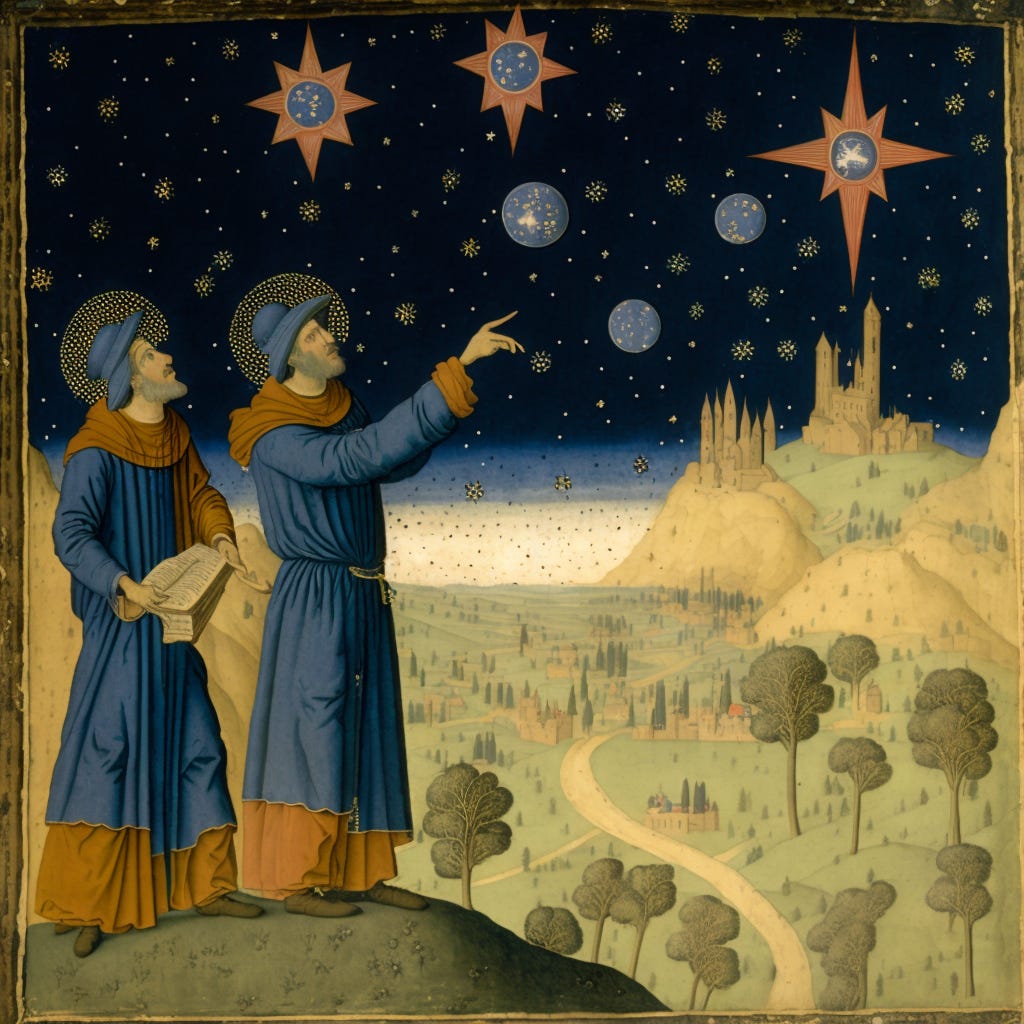


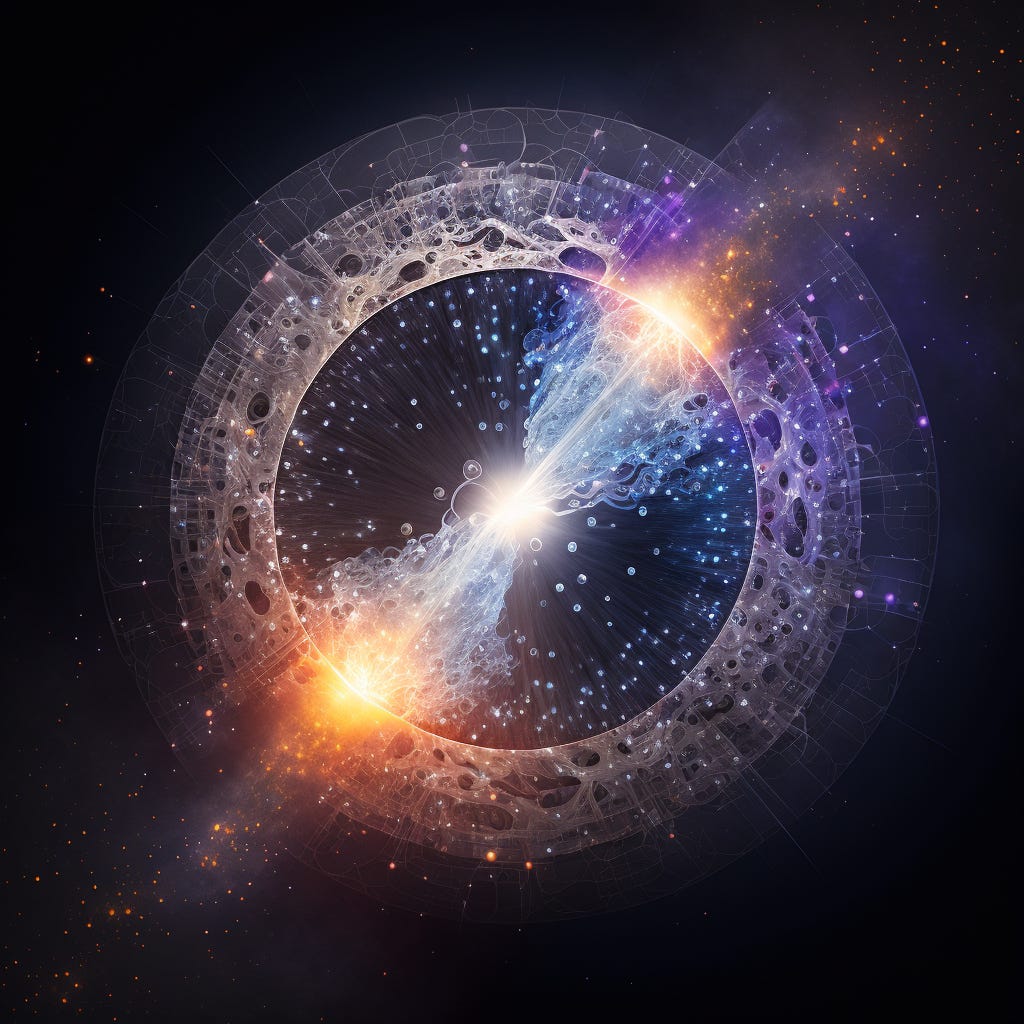

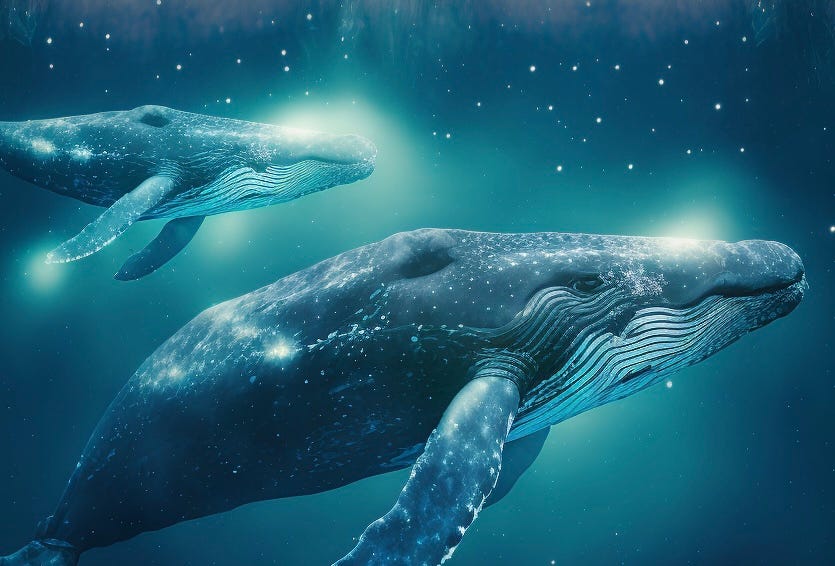
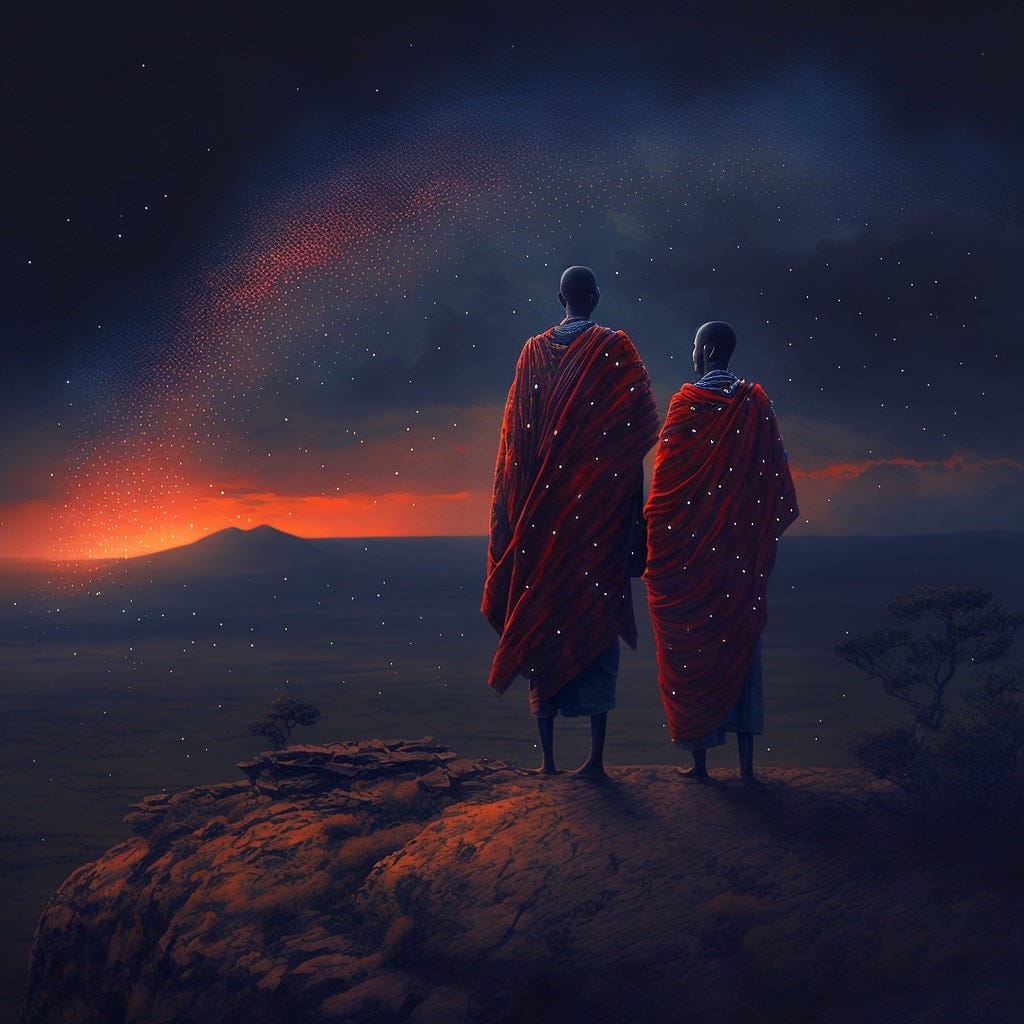

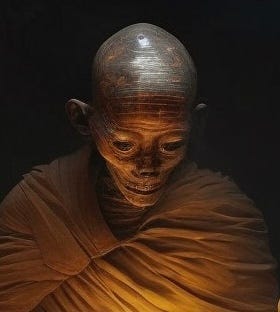



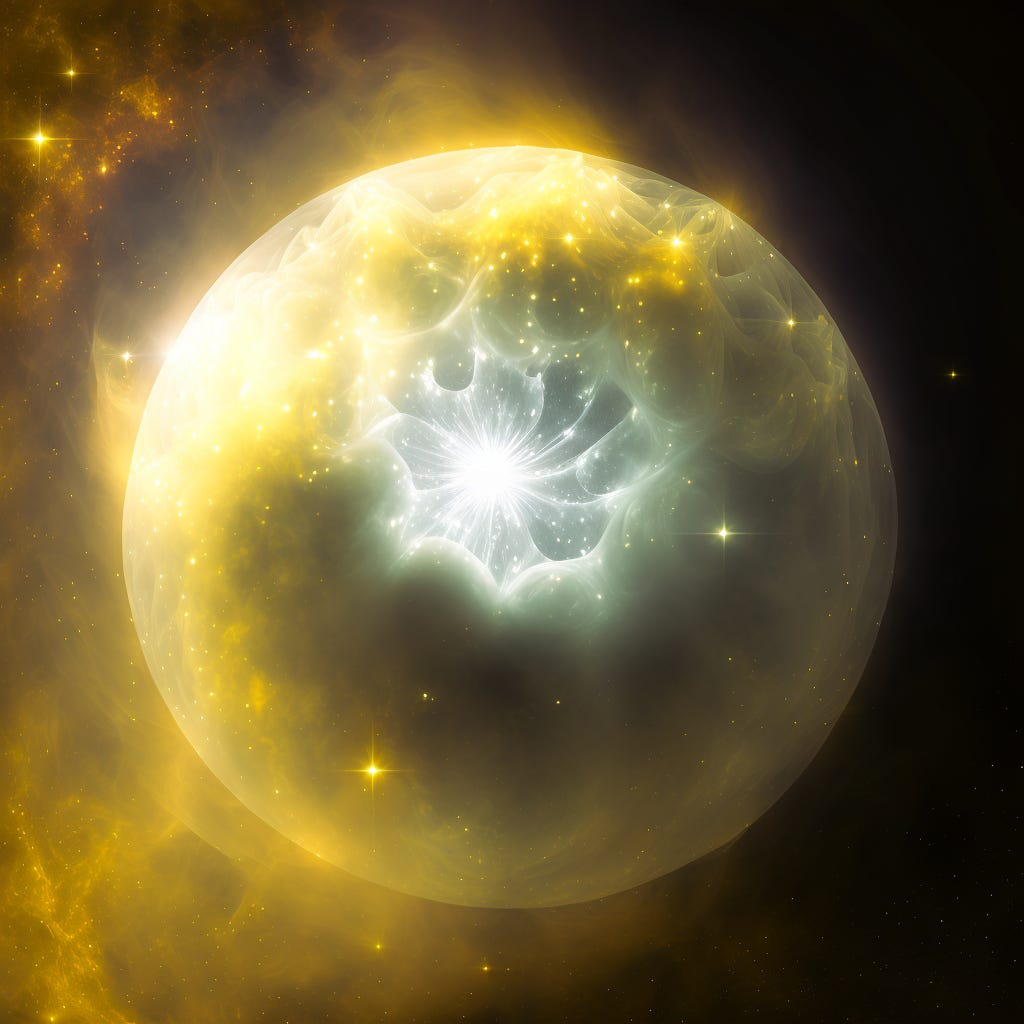
I love how seamlessly you've integrated the unique facts of this world into alternate histories and lore. It really grounds the story in the familiar while heightening the sense of the extraordinary. Like where this is heading!
Well, my primary thought is that this 'trip' has taken on more contexts than my astral cortex can keep track of and I am afraid existent v. non-existent is going to resolve horribly but blissfully unaware.